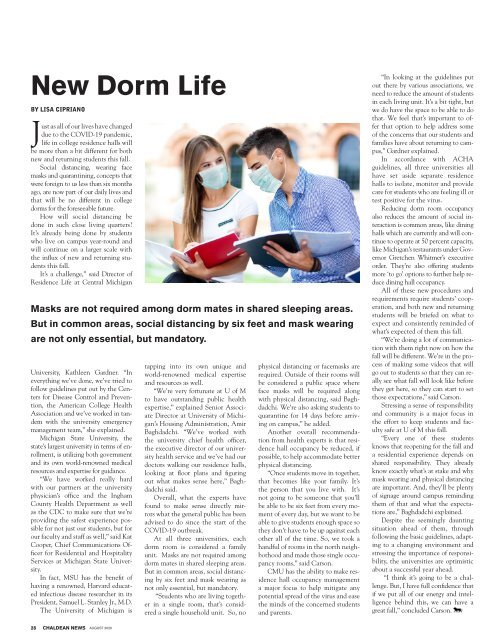AUGUST 2020
Create successful ePaper yourself
Turn your PDF publications into a flip-book with our unique Google optimized e-Paper software.
New Dorm Life<br />
BY LISA CIPRIANO<br />
Just as all of our lives have changed<br />
due to the COVID-19 pandemic,<br />
life in college residence halls will<br />
be more than a bit different for both<br />
new and returning students this fall.<br />
Social distancing, wearing face<br />
masks and quarantining, concepts that<br />
were foreign to us less than six months<br />
ago, are now part of our daily lives and<br />
that will be no different in college<br />
dorms for the foreseeable future.<br />
How will social distancing be<br />
done in such close living quarters?<br />
It’s already being done by students<br />
who live on campus year-round and<br />
will continue on a larger scale with<br />
the influx of new and returning students<br />
this fall.<br />
It’s a challenge,” said Director of<br />
Residence Life at Central Michigan<br />
Masks are not required among dorm mates in shared sleeping areas.<br />
But in common areas, social distancing by six feet and mask wearing<br />
are not only essential, but mandatory.<br />
University, Kathleen Gardner. “In<br />
everything we’ve done, we’ve tried to<br />
follow guidelines put out by the Centers<br />
for Disease Control and Prevention,<br />
the American College Health<br />
Association and we’ve worked in tandem<br />
with the university emergency<br />
management team,” she explained.<br />
Michigan State University, the<br />
state’s largest university in terms of enrollment,<br />
is utilizing both government<br />
and its own world-renowned medical<br />
resources and expertise for guidance.<br />
“We have worked really hard<br />
with our partners at the university<br />
physician’s office and the Ingham<br />
County Health Department as well<br />
as the CDC to make sure that we’re<br />
providing the safest experience possible<br />
for not just our students, but for<br />
our faculty and staff as well,” said Kat<br />
Cooper, Chief Communications Officer<br />
for Residential and Hospitality<br />
Services at Michigan State University.<br />
In fact, MSU has the benefit of<br />
having a renowned, Harvard educated<br />
infectious disease researcher in its<br />
President, Samuel L. Stanley Jr., M.D.<br />
The University of Michigan is<br />
tapping into its own unique and<br />
world-renowned medical expertise<br />
and resources as well.<br />
“We’re very fortunate at U of M<br />
to have outstanding public health<br />
expertise,” explained Senior Associate<br />
Director at University of Michigan’s<br />
Housing Administration, Amir<br />
Baghdadchi. “We’ve worked with<br />
the university chief health officer,<br />
the executive director of our university<br />
health service and we’ve had our<br />
doctors walking our residence halls,<br />
looking at floor plans and figuring<br />
out what makes sense here,” Baghdadchi<br />
said.<br />
Overall, what the experts have<br />
found to make sense directly mirrors<br />
what the general public has been<br />
advised to do since the start of the<br />
COVID-19 outbreak.<br />
At all three universities, each<br />
dorm room is considered a family<br />
unit. Masks are not required among<br />
dorm mates in shared sleeping areas.<br />
But in common areas, social distancing<br />
by six feet and mask wearing as<br />
not only essential, but mandatory.<br />
“Students who are living together<br />
in a single room, that’s considered<br />
a single household unit. So, no<br />
physical distancing or facemasks are<br />
required. Outside of their rooms will<br />
be considered a public space where<br />
face masks will be required along<br />
with physical distancing, said Baghdadchi.<br />
We’re also asking students to<br />
quarantine for 14 days before arriving<br />
on campus,” he added.<br />
Another overall recommendation<br />
from health experts is that residence<br />
hall occupancy be reduced, if<br />
possible, to help accommodate better<br />
physical distancing.<br />
“Once students move in together,<br />
that becomes like your family. It’s<br />
the person that you live with. It’s<br />
not going to be someone that you’ll<br />
be able to be six feet from every moment<br />
of every day, but we want to be<br />
able to give students enough space so<br />
they don’t have to be up against each<br />
other all of the time. So, we took a<br />
handful of rooms in the north neighborhood<br />
and made those single occupancy<br />
rooms,” said Carson.<br />
CMU has the ability to make residence<br />
hall occupancy management<br />
a major focus to help mitigate any<br />
potential spread of the virus and ease<br />
the minds of the concerned students<br />
and parents.<br />
“In looking at the guidelines put<br />
out there by various associations, we<br />
need to reduce the amount of students<br />
in each living unit. It’s a bit tight, but<br />
we do have the space to be able to do<br />
that. We feel that’s important to offer<br />
that option to help address some<br />
of the concerns that our students and<br />
families have about returning to campus,”<br />
Gardner explained.<br />
In accordance with ACHA<br />
guidelines, all three universities all<br />
have set aside separate residence<br />
halls to isolate, monitor and provide<br />
care for students who are feeling ill or<br />
test positive for the virus.<br />
Reducing dorm room occupancy<br />
also reduces the amount of social interaction<br />
is common areas, like dining<br />
halls which are currently and will continue<br />
to operate at 50 percent capacity,<br />
like Michigan’s restaurants under Governor<br />
Gretchen Whitmer’s executive<br />
order. They’re also offering students<br />
more ‘to go’ options to further help reduce<br />
dining hall occupancy.<br />
All of these new procedures and<br />
requirements require students’ cooperation,<br />
and both new and returning<br />
students will be briefed on what to<br />
expect and consistently reminded of<br />
what’s expected of them this fall.<br />
“We’re doing a lot of communication<br />
with them right now on how the<br />
fall will be different. We’re in the process<br />
of making some videos that will<br />
go out to students so that they can really<br />
see what fall will look like before<br />
they get here, so they can start to set<br />
those expectations,” said Carson.<br />
Stressing a sense of responsibility<br />
and community is a major focus in<br />
the effort to keep students and faculty<br />
safe at U of M this fall.<br />
“Every one of these students<br />
knows that reopening for the fall and<br />
a residential experience depends on<br />
shared responsibility. They already<br />
know exactly what’s at stake and why<br />
mask wearing and physical distancing<br />
are important. And, they’ll be plenty<br />
of signage around campus reminding<br />
them of that and what the expectations<br />
are,” Baghdadchi explained.<br />
Despite the seemingly daunting<br />
situation ahead of them, through<br />
following the basic guidelines, adapting<br />
to a changing environment and<br />
stressing the importance of responsibility,<br />
the universities are optimistic<br />
about a successful year ahead.<br />
“I think it’s going to be a challenge.<br />
But, I have full confidence that<br />
if we put all of our energy and intelligence<br />
behind this, we can have a<br />
great fall,” concluded Carson.<br />
28 CHALDEAN NEWS <strong>AUGUST</strong> <strong>2020</strong>

















